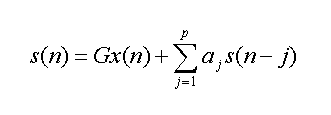LPC - Linear Predictive Coding
Alexis Ryan Razon
back to CE150
One of the most powerful speech analysis methods is that of Linear Predictive coding or LPC analysis as it is commonly referred to. In LPC analysis the short-term correlations between speech samples (formants) are modelled and removed by a very efficient short order filter. Another equally powerful and related method is pitch prediction. In pitch prediction, the long-term correlations of speech samples are modelled.
Before parameters can be extracted from a speech signal, it is necessary to have a theoretical model for the analysis. In speech processing, the source-filter model of speech production is generally used as a means of analysis. The time varying filter definition is affected by the combined spectral contributions of the glottal flow, the vocal tract and the radiation of the lips.

This equation can be transformed into the sampled time domain:

The above equation is well known as the LPC difference equation, which states that the value of the present output s(n), may be determined by summing the weighted present input Gx(n), and a weighted sum of the past output samples. Hence in LPC, the analysis of a speech signal is simplified because the result only gives parameters represented by aj, which are in short coefficients of the different corresponding segments. Moreover, LPC is already defined in MatLab.
In our project, LPC analysis was first implemented. However, due to the similarity of the coefficients and the number of data elements for the different commands, the group decided to implement another speech analysis method, which is the Threshold Method. Fortunately, the experience with LPC analysis made the Threshold Method a lot easier to use.
|